Advanced Clinical Decision Making for Pneumonia Patient
VerifiedAdded on 2023/06/06
|11
|3024
|186
AI Summary
This article discusses the clinical reasoning cycle for managing a patient with pneumonia. It covers the stages of the cycle, including collecting cues, processing information, identifying issues, establishing goals, taking actions, and evaluating outcomes. The article also relates the cycle to nursing competency standards and emphasizes the importance of evidence-based practice, assessment, and accountability.
Contribute Materials
Your contribution can guide someone’s learning journey. Share your
documents today.
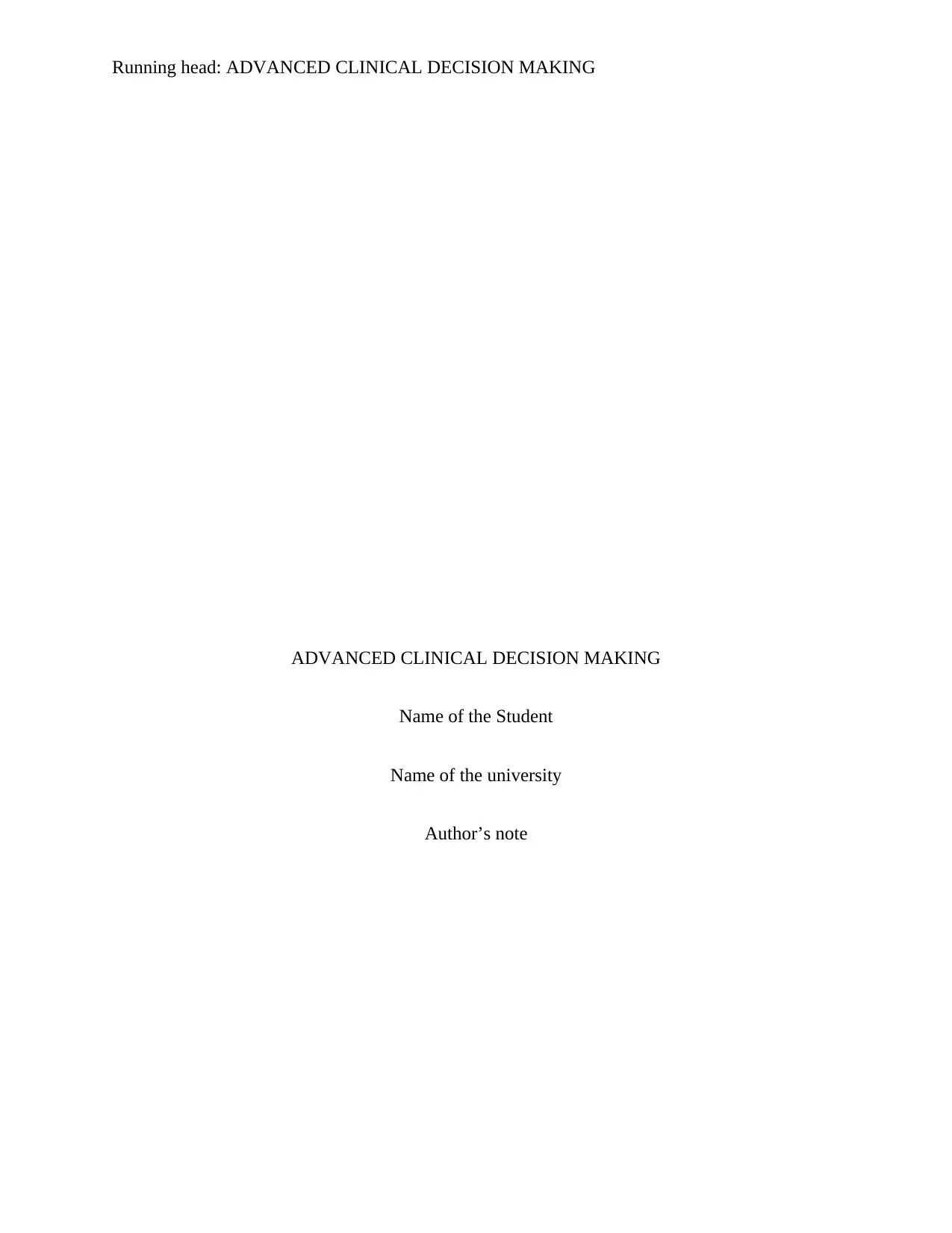
Running head: ADVANCED CLINICAL DECISION MAKING
ADVANCED CLINICAL DECISION MAKING
Name of the Student
Name of the university
Author’s note
ADVANCED CLINICAL DECISION MAKING
Name of the Student
Name of the university
Author’s note
Secure Best Marks with AI Grader
Need help grading? Try our AI Grader for instant feedback on your assignments.

1ADVANCED CLINICAL DECISION MAKING
Introduction
Registered nurses needs to be flexible in the in the decision making approach and to
ensure a continuity of care. In order to provide a safe and a high quality of care, they should
possess the ability to judge, think and reason. Clinical reasoning is a complex process that
utilizes the formal and informal reasoning strategies for gathering and the analyzing the patient
reasoning. This process is reliant on the health care professionals and the individual client
circumstances. In this assignment, the Levett Jone's clinical reasoning cycle has been used as a
tool for the registered nurses to make appropriate decisions. Furthermore the recommendations
has been proposed in the light of the three competency standards for the registered nurses by the
Nursing and Midwifery Board of Australia (NMBA) .
Consider the patient situation
A 45 years old male patient named James had been admitted to the ED with the clinical
manifestations of Pneumonia. The patient had been admitted with productive cough and
shortening of breath. The patient has been suffering from the respiratory tract infections for the
last five days. A local General practitioner had been managing the respiratory illness was
referred to the emergency department on the exacerbation of the respiratory distress. After
admitting the patient in the emergency department, the patient was subjected to chest x-ray,
which displayed a consolidated lungs that indicated towards the occurrence of pneumococcal
infections. I was allocated as the nurses for taking care of this patient.
Introduction
Registered nurses needs to be flexible in the in the decision making approach and to
ensure a continuity of care. In order to provide a safe and a high quality of care, they should
possess the ability to judge, think and reason. Clinical reasoning is a complex process that
utilizes the formal and informal reasoning strategies for gathering and the analyzing the patient
reasoning. This process is reliant on the health care professionals and the individual client
circumstances. In this assignment, the Levett Jone's clinical reasoning cycle has been used as a
tool for the registered nurses to make appropriate decisions. Furthermore the recommendations
has been proposed in the light of the three competency standards for the registered nurses by the
Nursing and Midwifery Board of Australia (NMBA) .
Consider the patient situation
A 45 years old male patient named James had been admitted to the ED with the clinical
manifestations of Pneumonia. The patient had been admitted with productive cough and
shortening of breath. The patient has been suffering from the respiratory tract infections for the
last five days. A local General practitioner had been managing the respiratory illness was
referred to the emergency department on the exacerbation of the respiratory distress. After
admitting the patient in the emergency department, the patient was subjected to chest x-ray,
which displayed a consolidated lungs that indicated towards the occurrence of pneumococcal
infections. I was allocated as the nurses for taking care of this patient.

2ADVANCED CLINICAL DECISION MAKING
Collect cues/information
This is the second stage of the clinical reasoning cycle where nurses are accountable to
review the current information of the patient based upon the diagnostic tests. On arrival to the
emergency department vital signs of James were taken and recorded. The recorded temperature
was 38.8 degree Celsius. Heart rate was observed to 110beats per minute, respiratory rate 26 per
minutes, blood pressure was recorded to be 100/72 and oxygen saturation level was found to be
91 %. The doctored ordered for an hourly monitoring of the breathing, LOC and the neurological
status. James was initially admitted with an oxygen saturation level of 91 % which decreased
with time and was reduced to 87%, with increasing respiratory distress. Right after an hour of
admission the patient exhibited high fever with increasing respiratory problem. The current PaO2
level was observed to be 50mmHg. One of the main concern for James is the increasing
respiratory distress and the decreasing oxygen saturation level. The blood pH was recorded to be
7.45. I have recorded all the observations and reported the abnormal signs to the registered nurse,
who gave the order of reporting to a doctor.
Process information
Processing of the information is the third stage of the clinical reasoning cycle where all
the displayed signs and the symptoms are linked to the underlying pathophysiology,
pharmacology and the pharmacodynamics. The normal vital signs are compared with the
abnormal. Pneumonia is an acute form of respiratory tract infections that affect the lung
parenchyma and oxygenation of the lungs. The clinical manifestations are mainly monitored by a
chest x-ray (Singh, 2012).
Collect cues/information
This is the second stage of the clinical reasoning cycle where nurses are accountable to
review the current information of the patient based upon the diagnostic tests. On arrival to the
emergency department vital signs of James were taken and recorded. The recorded temperature
was 38.8 degree Celsius. Heart rate was observed to 110beats per minute, respiratory rate 26 per
minutes, blood pressure was recorded to be 100/72 and oxygen saturation level was found to be
91 %. The doctored ordered for an hourly monitoring of the breathing, LOC and the neurological
status. James was initially admitted with an oxygen saturation level of 91 % which decreased
with time and was reduced to 87%, with increasing respiratory distress. Right after an hour of
admission the patient exhibited high fever with increasing respiratory problem. The current PaO2
level was observed to be 50mmHg. One of the main concern for James is the increasing
respiratory distress and the decreasing oxygen saturation level. The blood pH was recorded to be
7.45. I have recorded all the observations and reported the abnormal signs to the registered nurse,
who gave the order of reporting to a doctor.
Process information
Processing of the information is the third stage of the clinical reasoning cycle where all
the displayed signs and the symptoms are linked to the underlying pathophysiology,
pharmacology and the pharmacodynamics. The normal vital signs are compared with the
abnormal. Pneumonia is an acute form of respiratory tract infections that affect the lung
parenchyma and oxygenation of the lungs. The clinical manifestations are mainly monitored by a
chest x-ray (Singh, 2012).
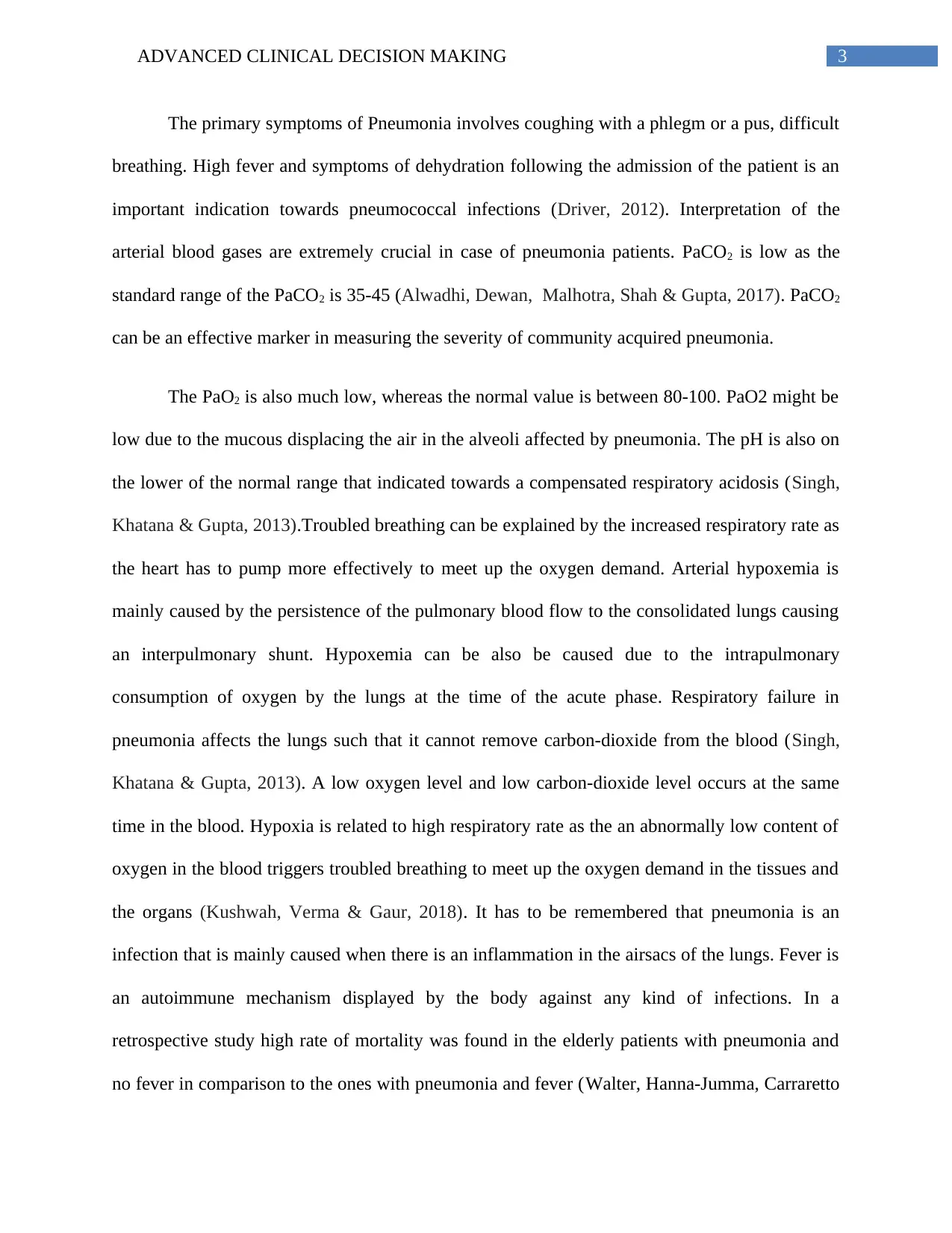
3ADVANCED CLINICAL DECISION MAKING
The primary symptoms of Pneumonia involves coughing with a phlegm or a pus, difficult
breathing. High fever and symptoms of dehydration following the admission of the patient is an
important indication towards pneumococcal infections (Driver, 2012). Interpretation of the
arterial blood gases are extremely crucial in case of pneumonia patients. PaCO2 is low as the
standard range of the PaCO2 is 35-45 (Alwadhi, Dewan, Malhotra, Shah & Gupta, 2017). PaCO2
can be an effective marker in measuring the severity of community acquired pneumonia.
The PaO2 is also much low, whereas the normal value is between 80-100. PaO2 might be
low due to the mucous displacing the air in the alveoli affected by pneumonia. The pH is also on
the lower of the normal range that indicated towards a compensated respiratory acidosis (Singh,
Khatana & Gupta, 2013).Troubled breathing can be explained by the increased respiratory rate as
the heart has to pump more effectively to meet up the oxygen demand. Arterial hypoxemia is
mainly caused by the persistence of the pulmonary blood flow to the consolidated lungs causing
an interpulmonary shunt. Hypoxemia can be also be caused due to the intrapulmonary
consumption of oxygen by the lungs at the time of the acute phase. Respiratory failure in
pneumonia affects the lungs such that it cannot remove carbon-dioxide from the blood (Singh,
Khatana & Gupta, 2013). A low oxygen level and low carbon-dioxide level occurs at the same
time in the blood. Hypoxia is related to high respiratory rate as the an abnormally low content of
oxygen in the blood triggers troubled breathing to meet up the oxygen demand in the tissues and
the organs (Kushwah, Verma & Gaur, 2018). It has to be remembered that pneumonia is an
infection that is mainly caused when there is an inflammation in the airsacs of the lungs. Fever is
an autoimmune mechanism displayed by the body against any kind of infections. In a
retrospective study high rate of mortality was found in the elderly patients with pneumonia and
no fever in comparison to the ones with pneumonia and fever (Walter, Hanna-Jumma, Carraretto
The primary symptoms of Pneumonia involves coughing with a phlegm or a pus, difficult
breathing. High fever and symptoms of dehydration following the admission of the patient is an
important indication towards pneumococcal infections (Driver, 2012). Interpretation of the
arterial blood gases are extremely crucial in case of pneumonia patients. PaCO2 is low as the
standard range of the PaCO2 is 35-45 (Alwadhi, Dewan, Malhotra, Shah & Gupta, 2017). PaCO2
can be an effective marker in measuring the severity of community acquired pneumonia.
The PaO2 is also much low, whereas the normal value is between 80-100. PaO2 might be
low due to the mucous displacing the air in the alveoli affected by pneumonia. The pH is also on
the lower of the normal range that indicated towards a compensated respiratory acidosis (Singh,
Khatana & Gupta, 2013).Troubled breathing can be explained by the increased respiratory rate as
the heart has to pump more effectively to meet up the oxygen demand. Arterial hypoxemia is
mainly caused by the persistence of the pulmonary blood flow to the consolidated lungs causing
an interpulmonary shunt. Hypoxemia can be also be caused due to the intrapulmonary
consumption of oxygen by the lungs at the time of the acute phase. Respiratory failure in
pneumonia affects the lungs such that it cannot remove carbon-dioxide from the blood (Singh,
Khatana & Gupta, 2013). A low oxygen level and low carbon-dioxide level occurs at the same
time in the blood. Hypoxia is related to high respiratory rate as the an abnormally low content of
oxygen in the blood triggers troubled breathing to meet up the oxygen demand in the tissues and
the organs (Kushwah, Verma & Gaur, 2018). It has to be remembered that pneumonia is an
infection that is mainly caused when there is an inflammation in the airsacs of the lungs. Fever is
an autoimmune mechanism displayed by the body against any kind of infections. In a
retrospective study high rate of mortality was found in the elderly patients with pneumonia and
no fever in comparison to the ones with pneumonia and fever (Walter, Hanna-Jumma, Carraretto
Secure Best Marks with AI Grader
Need help grading? Try our AI Grader for instant feedback on your assignments.
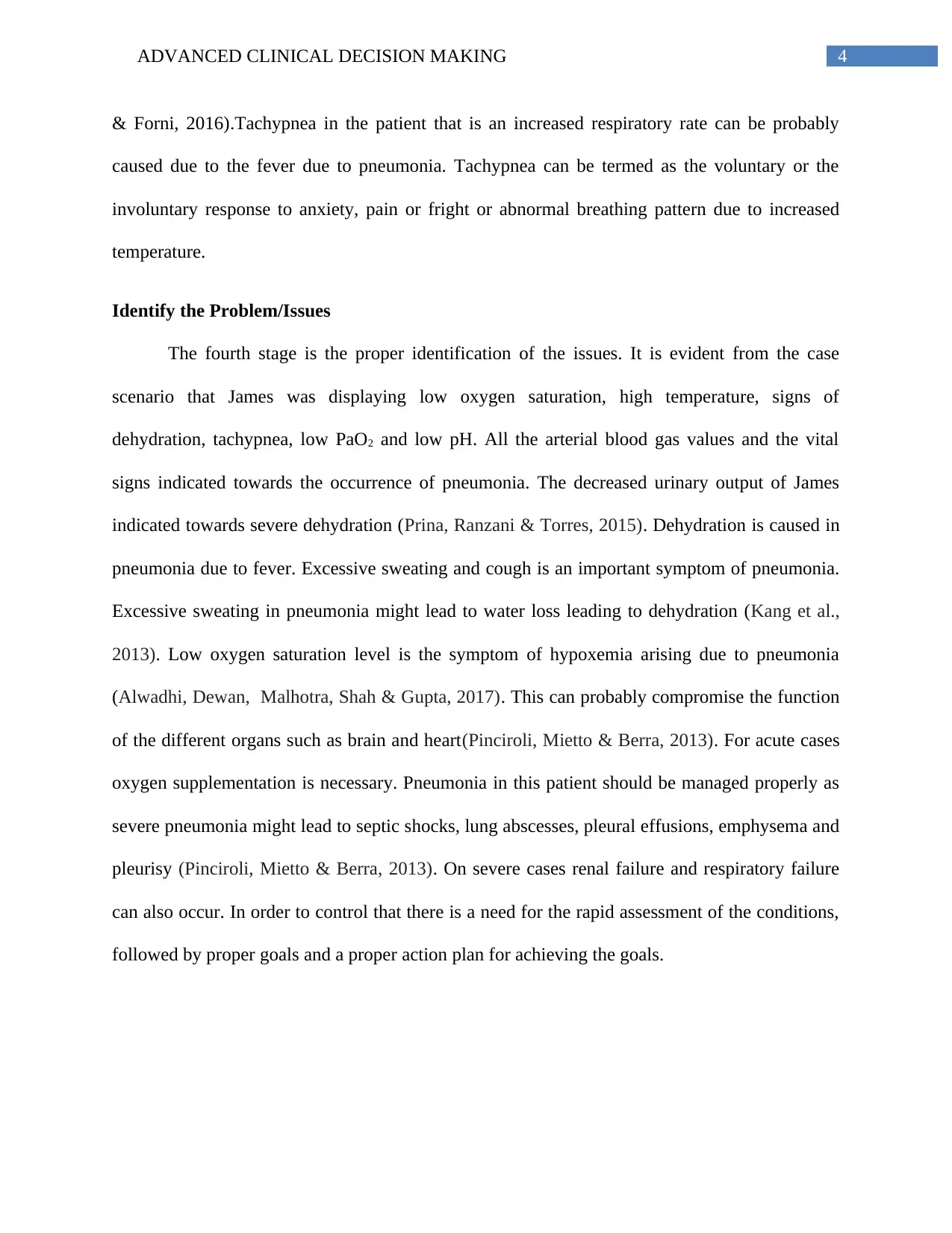
4ADVANCED CLINICAL DECISION MAKING
& Forni, 2016).Tachypnea in the patient that is an increased respiratory rate can be probably
caused due to the fever due to pneumonia. Tachypnea can be termed as the voluntary or the
involuntary response to anxiety, pain or fright or abnormal breathing pattern due to increased
temperature.
Identify the Problem/Issues
The fourth stage is the proper identification of the issues. It is evident from the case
scenario that James was displaying low oxygen saturation, high temperature, signs of
dehydration, tachypnea, low PaO2 and low pH. All the arterial blood gas values and the vital
signs indicated towards the occurrence of pneumonia. The decreased urinary output of James
indicated towards severe dehydration (Prina, Ranzani & Torres, 2015). Dehydration is caused in
pneumonia due to fever. Excessive sweating and cough is an important symptom of pneumonia.
Excessive sweating in pneumonia might lead to water loss leading to dehydration (Kang et al.,
2013). Low oxygen saturation level is the symptom of hypoxemia arising due to pneumonia
(Alwadhi, Dewan, Malhotra, Shah & Gupta, 2017). This can probably compromise the function
of the different organs such as brain and heart(Pinciroli, Mietto & Berra, 2013). For acute cases
oxygen supplementation is necessary. Pneumonia in this patient should be managed properly as
severe pneumonia might lead to septic shocks, lung abscesses, pleural effusions, emphysema and
pleurisy (Pinciroli, Mietto & Berra, 2013). On severe cases renal failure and respiratory failure
can also occur. In order to control that there is a need for the rapid assessment of the conditions,
followed by proper goals and a proper action plan for achieving the goals.
& Forni, 2016).Tachypnea in the patient that is an increased respiratory rate can be probably
caused due to the fever due to pneumonia. Tachypnea can be termed as the voluntary or the
involuntary response to anxiety, pain or fright or abnormal breathing pattern due to increased
temperature.
Identify the Problem/Issues
The fourth stage is the proper identification of the issues. It is evident from the case
scenario that James was displaying low oxygen saturation, high temperature, signs of
dehydration, tachypnea, low PaO2 and low pH. All the arterial blood gas values and the vital
signs indicated towards the occurrence of pneumonia. The decreased urinary output of James
indicated towards severe dehydration (Prina, Ranzani & Torres, 2015). Dehydration is caused in
pneumonia due to fever. Excessive sweating and cough is an important symptom of pneumonia.
Excessive sweating in pneumonia might lead to water loss leading to dehydration (Kang et al.,
2013). Low oxygen saturation level is the symptom of hypoxemia arising due to pneumonia
(Alwadhi, Dewan, Malhotra, Shah & Gupta, 2017). This can probably compromise the function
of the different organs such as brain and heart(Pinciroli, Mietto & Berra, 2013). For acute cases
oxygen supplementation is necessary. Pneumonia in this patient should be managed properly as
severe pneumonia might lead to septic shocks, lung abscesses, pleural effusions, emphysema and
pleurisy (Pinciroli, Mietto & Berra, 2013). On severe cases renal failure and respiratory failure
can also occur. In order to control that there is a need for the rapid assessment of the conditions,
followed by proper goals and a proper action plan for achieving the goals.
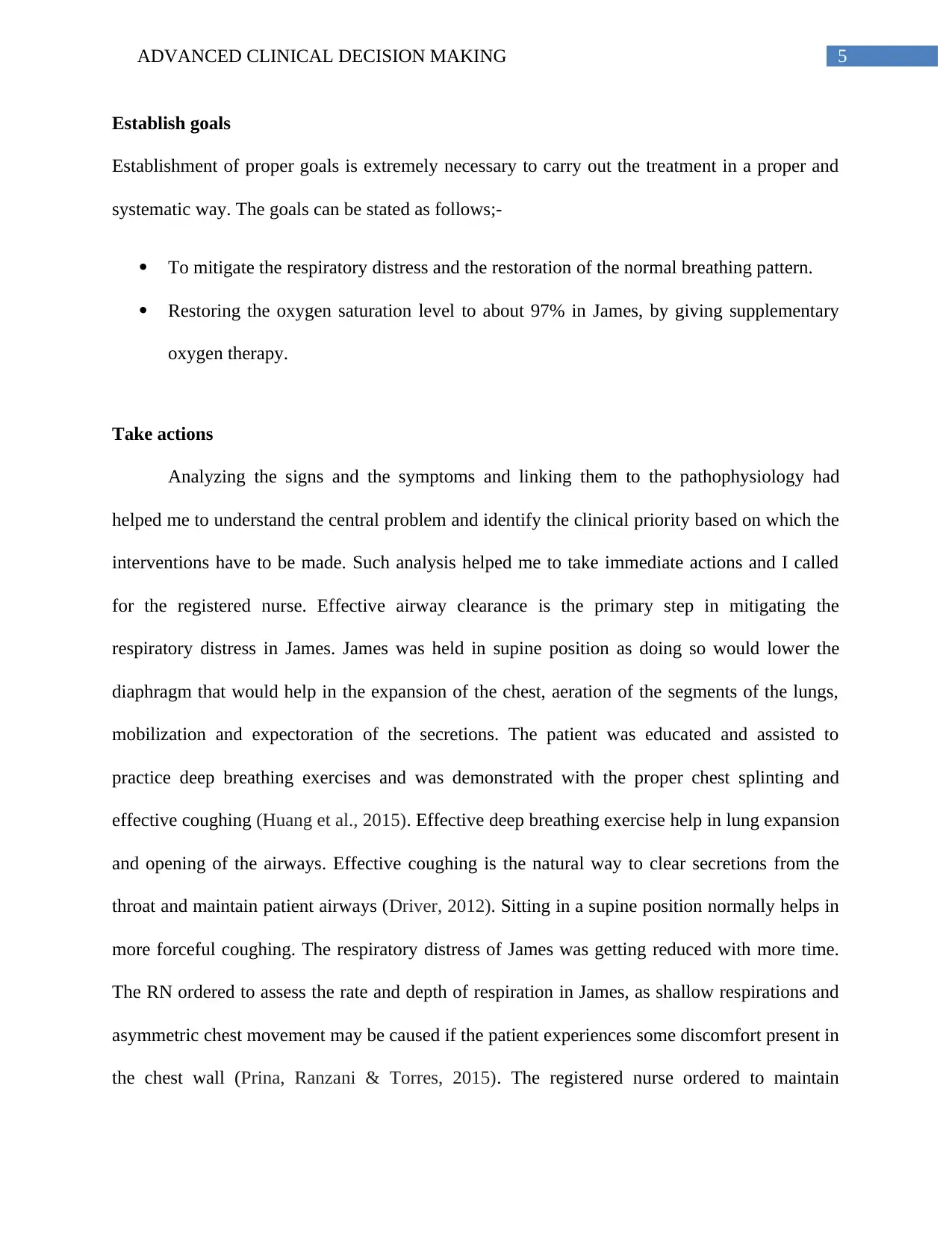
5ADVANCED CLINICAL DECISION MAKING
Establish goals
Establishment of proper goals is extremely necessary to carry out the treatment in a proper and
systematic way. The goals can be stated as follows;-
To mitigate the respiratory distress and the restoration of the normal breathing pattern.
Restoring the oxygen saturation level to about 97% in James, by giving supplementary
oxygen therapy.
Take actions
Analyzing the signs and the symptoms and linking them to the pathophysiology had
helped me to understand the central problem and identify the clinical priority based on which the
interventions have to be made. Such analysis helped me to take immediate actions and I called
for the registered nurse. Effective airway clearance is the primary step in mitigating the
respiratory distress in James. James was held in supine position as doing so would lower the
diaphragm that would help in the expansion of the chest, aeration of the segments of the lungs,
mobilization and expectoration of the secretions. The patient was educated and assisted to
practice deep breathing exercises and was demonstrated with the proper chest splinting and
effective coughing (Huang et al., 2015). Effective deep breathing exercise help in lung expansion
and opening of the airways. Effective coughing is the natural way to clear secretions from the
throat and maintain patient airways (Driver, 2012). Sitting in a supine position normally helps in
more forceful coughing. The respiratory distress of James was getting reduced with more time.
The RN ordered to assess the rate and depth of respiration in James, as shallow respirations and
asymmetric chest movement may be caused if the patient experiences some discomfort present in
the chest wall (Prina, Ranzani & Torres, 2015). The registered nurse ordered to maintain
Establish goals
Establishment of proper goals is extremely necessary to carry out the treatment in a proper and
systematic way. The goals can be stated as follows;-
To mitigate the respiratory distress and the restoration of the normal breathing pattern.
Restoring the oxygen saturation level to about 97% in James, by giving supplementary
oxygen therapy.
Take actions
Analyzing the signs and the symptoms and linking them to the pathophysiology had
helped me to understand the central problem and identify the clinical priority based on which the
interventions have to be made. Such analysis helped me to take immediate actions and I called
for the registered nurse. Effective airway clearance is the primary step in mitigating the
respiratory distress in James. James was held in supine position as doing so would lower the
diaphragm that would help in the expansion of the chest, aeration of the segments of the lungs,
mobilization and expectoration of the secretions. The patient was educated and assisted to
practice deep breathing exercises and was demonstrated with the proper chest splinting and
effective coughing (Huang et al., 2015). Effective deep breathing exercise help in lung expansion
and opening of the airways. Effective coughing is the natural way to clear secretions from the
throat and maintain patient airways (Driver, 2012). Sitting in a supine position normally helps in
more forceful coughing. The respiratory distress of James was getting reduced with more time.
The RN ordered to assess the rate and depth of respiration in James, as shallow respirations and
asymmetric chest movement may be caused if the patient experiences some discomfort present in
the chest wall (Prina, Ranzani & Torres, 2015). The registered nurse ordered to maintain

6ADVANCED CLINICAL DECISION MAKING
2-4L/minnasal prongs. The prime purpose of the oxygen therapy is to maintain the PaO2 above
66mmHg (Fealy et al., 2016). I made sure that the oxygen level is tolerable to the patient. The
arterial blood gases, neurological signs and the vital signs were monitored at an interval of every
two hours.
Evaluate Outcomes
Evaluation of the outcomes is the seventh stage of the clinical reasoning cycle that proves
that the actions taken have met the goals successfully or not. The outcome in case of James had
been positive, specifically in terms of the oxygen saturation level and the respiratory rate. The
oxygen saturation level in James finally rose to 96%, which is within the normal value and
display enough oxygen level in the blood. Naturally, the respiratory distress in James was
lowered to a considerable extent. The PaO2 value is also restored to a normal level, ensuring an
improved ventilation and oxygenation of the tissues within the acceptable range (Singh, Khatana
& Gupta, 2013). James was finally able to take part in the actions to maximize oxygenation.
Airway clearance was demonstrated by positive changes in the depth and the rate of the
respiration. Tachypnea was found to be under control and ABG values were found to be
normalizing gradually.
Reflection
Reflecting on the experiences and understandings is the final stage of the clinical
reasoning cycle. According to Levett Jones et al.(2011), clinical reasoning cycle helps the health
care professionals to identify a specific health problem and facilitates the thinking behind the
plan of management. It has to be remembered that medical decisions are complicated and based
on different internal and external parameters. Hence it is the need of the health care professionals
2-4L/minnasal prongs. The prime purpose of the oxygen therapy is to maintain the PaO2 above
66mmHg (Fealy et al., 2016). I made sure that the oxygen level is tolerable to the patient. The
arterial blood gases, neurological signs and the vital signs were monitored at an interval of every
two hours.
Evaluate Outcomes
Evaluation of the outcomes is the seventh stage of the clinical reasoning cycle that proves
that the actions taken have met the goals successfully or not. The outcome in case of James had
been positive, specifically in terms of the oxygen saturation level and the respiratory rate. The
oxygen saturation level in James finally rose to 96%, which is within the normal value and
display enough oxygen level in the blood. Naturally, the respiratory distress in James was
lowered to a considerable extent. The PaO2 value is also restored to a normal level, ensuring an
improved ventilation and oxygenation of the tissues within the acceptable range (Singh, Khatana
& Gupta, 2013). James was finally able to take part in the actions to maximize oxygenation.
Airway clearance was demonstrated by positive changes in the depth and the rate of the
respiration. Tachypnea was found to be under control and ABG values were found to be
normalizing gradually.
Reflection
Reflecting on the experiences and understandings is the final stage of the clinical
reasoning cycle. According to Levett Jones et al.(2011), clinical reasoning cycle helps the health
care professionals to identify a specific health problem and facilitates the thinking behind the
plan of management. It has to be remembered that medical decisions are complicated and based
on different internal and external parameters. Hence it is the need of the health care professionals
Paraphrase This Document
Need a fresh take? Get an instant paraphrase of this document with our AI Paraphraser
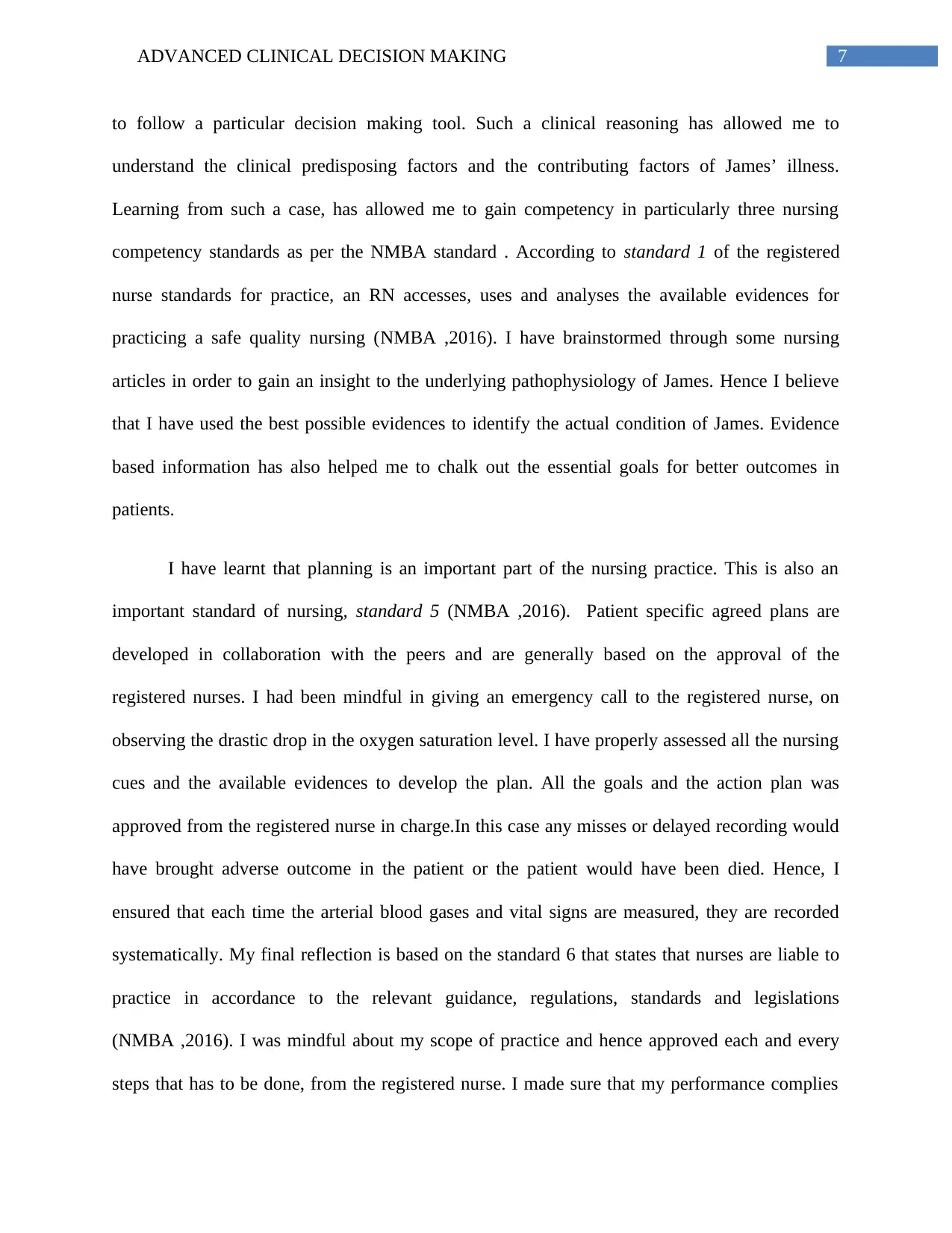
7ADVANCED CLINICAL DECISION MAKING
to follow a particular decision making tool. Such a clinical reasoning has allowed me to
understand the clinical predisposing factors and the contributing factors of James’ illness.
Learning from such a case, has allowed me to gain competency in particularly three nursing
competency standards as per the NMBA standard . According to standard 1 of the registered
nurse standards for practice, an RN accesses, uses and analyses the available evidences for
practicing a safe quality nursing (NMBA ,2016). I have brainstormed through some nursing
articles in order to gain an insight to the underlying pathophysiology of James. Hence I believe
that I have used the best possible evidences to identify the actual condition of James. Evidence
based information has also helped me to chalk out the essential goals for better outcomes in
patients.
I have learnt that planning is an important part of the nursing practice. This is also an
important standard of nursing, standard 5 (NMBA ,2016). Patient specific agreed plans are
developed in collaboration with the peers and are generally based on the approval of the
registered nurses. I had been mindful in giving an emergency call to the registered nurse, on
observing the drastic drop in the oxygen saturation level. I have properly assessed all the nursing
cues and the available evidences to develop the plan. All the goals and the action plan was
approved from the registered nurse in charge.In this case any misses or delayed recording would
have brought adverse outcome in the patient or the patient would have been died. Hence, I
ensured that each time the arterial blood gases and vital signs are measured, they are recorded
systematically. My final reflection is based on the standard 6 that states that nurses are liable to
practice in accordance to the relevant guidance, regulations, standards and legislations
(NMBA ,2016). I was mindful about my scope of practice and hence approved each and every
steps that has to be done, from the registered nurse. I made sure that my performance complies
to follow a particular decision making tool. Such a clinical reasoning has allowed me to
understand the clinical predisposing factors and the contributing factors of James’ illness.
Learning from such a case, has allowed me to gain competency in particularly three nursing
competency standards as per the NMBA standard . According to standard 1 of the registered
nurse standards for practice, an RN accesses, uses and analyses the available evidences for
practicing a safe quality nursing (NMBA ,2016). I have brainstormed through some nursing
articles in order to gain an insight to the underlying pathophysiology of James. Hence I believe
that I have used the best possible evidences to identify the actual condition of James. Evidence
based information has also helped me to chalk out the essential goals for better outcomes in
patients.
I have learnt that planning is an important part of the nursing practice. This is also an
important standard of nursing, standard 5 (NMBA ,2016). Patient specific agreed plans are
developed in collaboration with the peers and are generally based on the approval of the
registered nurses. I had been mindful in giving an emergency call to the registered nurse, on
observing the drastic drop in the oxygen saturation level. I have properly assessed all the nursing
cues and the available evidences to develop the plan. All the goals and the action plan was
approved from the registered nurse in charge.In this case any misses or delayed recording would
have brought adverse outcome in the patient or the patient would have been died. Hence, I
ensured that each time the arterial blood gases and vital signs are measured, they are recorded
systematically. My final reflection is based on the standard 6 that states that nurses are liable to
practice in accordance to the relevant guidance, regulations, standards and legislations
(NMBA ,2016). I was mindful about my scope of practice and hence approved each and every
steps that has to be done, from the registered nurse. I made sure that my performance complies
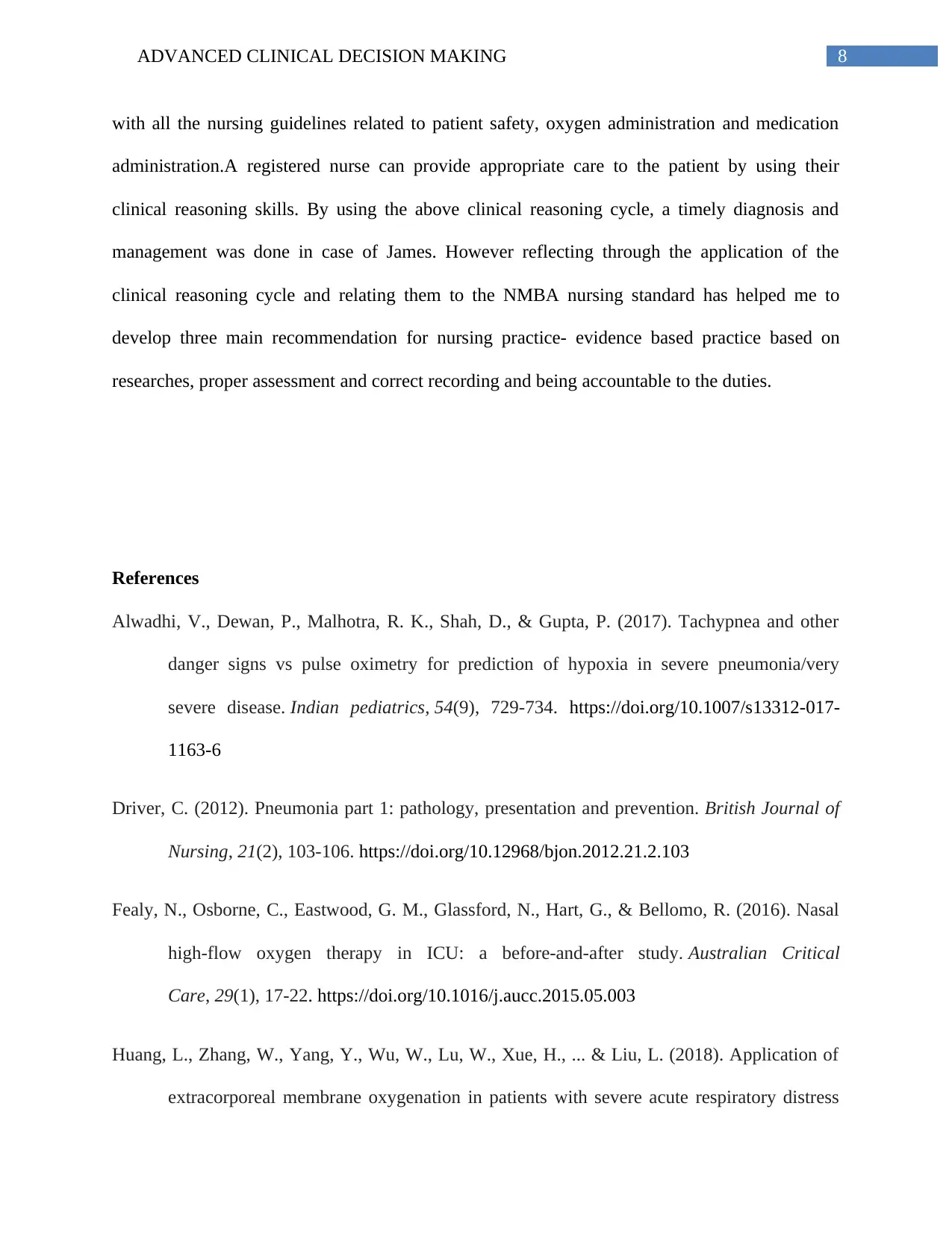
8ADVANCED CLINICAL DECISION MAKING
with all the nursing guidelines related to patient safety, oxygen administration and medication
administration.A registered nurse can provide appropriate care to the patient by using their
clinical reasoning skills. By using the above clinical reasoning cycle, a timely diagnosis and
management was done in case of James. However reflecting through the application of the
clinical reasoning cycle and relating them to the NMBA nursing standard has helped me to
develop three main recommendation for nursing practice- evidence based practice based on
researches, proper assessment and correct recording and being accountable to the duties.
References
Alwadhi, V., Dewan, P., Malhotra, R. K., Shah, D., & Gupta, P. (2017). Tachypnea and other
danger signs vs pulse oximetry for prediction of hypoxia in severe pneumonia/very
severe disease. Indian pediatrics, 54(9), 729-734. https://doi.org/10.1007/s13312-017-
1163-6
Driver, C. (2012). Pneumonia part 1: pathology, presentation and prevention. British Journal of
Nursing, 21(2), 103-106. https://doi.org/10.12968/bjon.2012.21.2.103
Fealy, N., Osborne, C., Eastwood, G. M., Glassford, N., Hart, G., & Bellomo, R. (2016). Nasal
high-flow oxygen therapy in ICU: a before-and-after study. Australian Critical
Care, 29(1), 17-22. https://doi.org/10.1016/j.aucc.2015.05.003
Huang, L., Zhang, W., Yang, Y., Wu, W., Lu, W., Xue, H., ... & Liu, L. (2018). Application of
extracorporeal membrane oxygenation in patients with severe acute respiratory distress
with all the nursing guidelines related to patient safety, oxygen administration and medication
administration.A registered nurse can provide appropriate care to the patient by using their
clinical reasoning skills. By using the above clinical reasoning cycle, a timely diagnosis and
management was done in case of James. However reflecting through the application of the
clinical reasoning cycle and relating them to the NMBA nursing standard has helped me to
develop three main recommendation for nursing practice- evidence based practice based on
researches, proper assessment and correct recording and being accountable to the duties.
References
Alwadhi, V., Dewan, P., Malhotra, R. K., Shah, D., & Gupta, P. (2017). Tachypnea and other
danger signs vs pulse oximetry for prediction of hypoxia in severe pneumonia/very
severe disease. Indian pediatrics, 54(9), 729-734. https://doi.org/10.1007/s13312-017-
1163-6
Driver, C. (2012). Pneumonia part 1: pathology, presentation and prevention. British Journal of
Nursing, 21(2), 103-106. https://doi.org/10.12968/bjon.2012.21.2.103
Fealy, N., Osborne, C., Eastwood, G. M., Glassford, N., Hart, G., & Bellomo, R. (2016). Nasal
high-flow oxygen therapy in ICU: a before-and-after study. Australian Critical
Care, 29(1), 17-22. https://doi.org/10.1016/j.aucc.2015.05.003
Huang, L., Zhang, W., Yang, Y., Wu, W., Lu, W., Xue, H., ... & Liu, L. (2018). Application of
extracorporeal membrane oxygenation in patients with severe acute respiratory distress
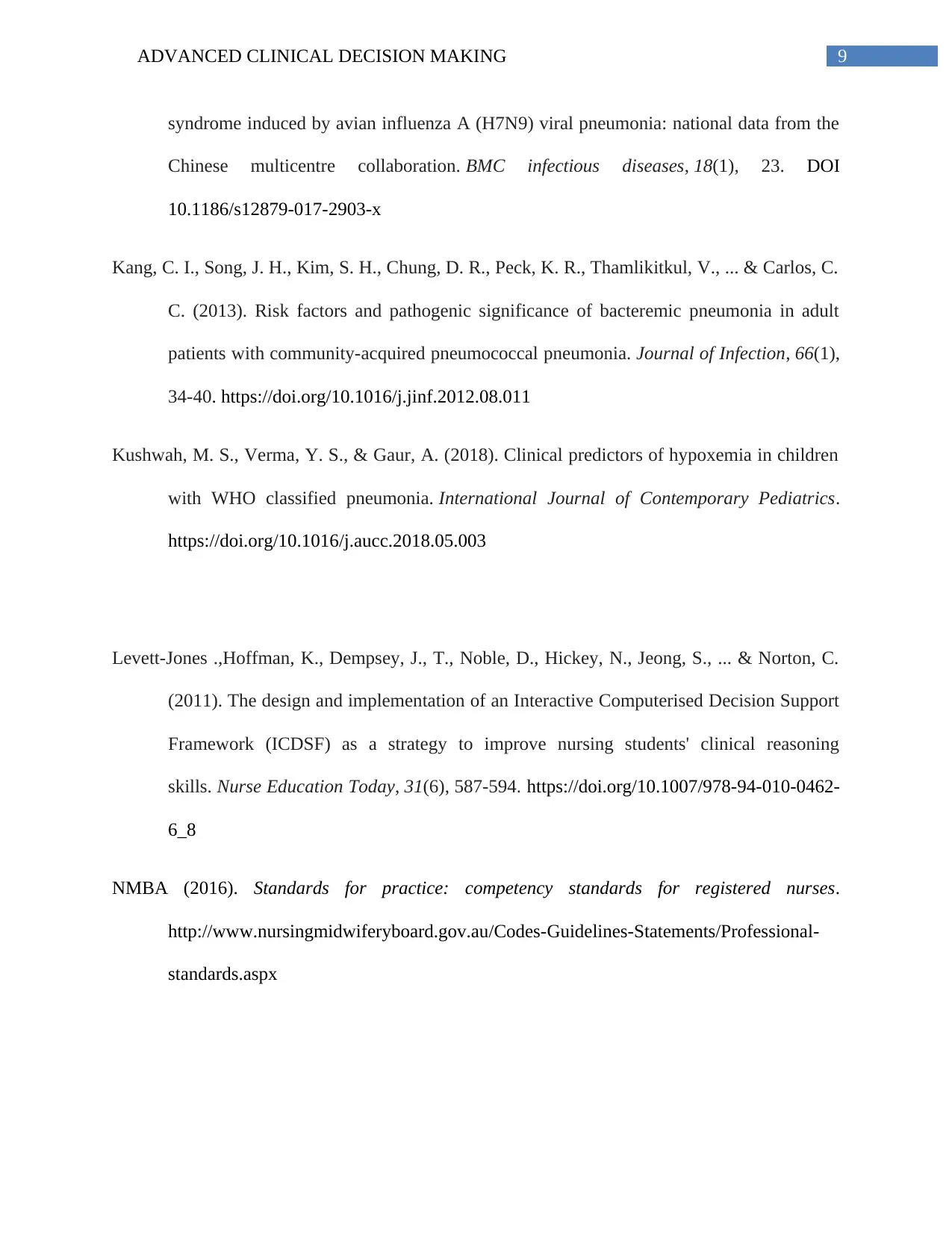
9ADVANCED CLINICAL DECISION MAKING
syndrome induced by avian influenza A (H7N9) viral pneumonia: national data from the
Chinese multicentre collaboration. BMC infectious diseases, 18(1), 23. DOI
10.1186/s12879-017-2903-x
Kang, C. I., Song, J. H., Kim, S. H., Chung, D. R., Peck, K. R., Thamlikitkul, V., ... & Carlos, C.
C. (2013). Risk factors and pathogenic significance of bacteremic pneumonia in adult
patients with community-acquired pneumococcal pneumonia. Journal of Infection, 66(1),
34-40. https://doi.org/10.1016/j.jinf.2012.08.011
Kushwah, M. S., Verma, Y. S., & Gaur, A. (2018). Clinical predictors of hypoxemia in children
with WHO classified pneumonia. International Journal of Contemporary Pediatrics.
https://doi.org/10.1016/j.aucc.2018.05.003
Levett-Jones .,Hoffman, K., Dempsey, J., T., Noble, D., Hickey, N., Jeong, S., ... & Norton, C.
(2011). The design and implementation of an Interactive Computerised Decision Support
Framework (ICDSF) as a strategy to improve nursing students' clinical reasoning
skills. Nurse Education Today, 31(6), 587-594. https://doi.org/10.1007/978-94-010-0462-
6_8
NMBA (2016). Standards for practice: competency standards for registered nurses.
http://www.nursingmidwiferyboard.gov.au/Codes-Guidelines-Statements/Professional-
standards.aspx
syndrome induced by avian influenza A (H7N9) viral pneumonia: national data from the
Chinese multicentre collaboration. BMC infectious diseases, 18(1), 23. DOI
10.1186/s12879-017-2903-x
Kang, C. I., Song, J. H., Kim, S. H., Chung, D. R., Peck, K. R., Thamlikitkul, V., ... & Carlos, C.
C. (2013). Risk factors and pathogenic significance of bacteremic pneumonia in adult
patients with community-acquired pneumococcal pneumonia. Journal of Infection, 66(1),
34-40. https://doi.org/10.1016/j.jinf.2012.08.011
Kushwah, M. S., Verma, Y. S., & Gaur, A. (2018). Clinical predictors of hypoxemia in children
with WHO classified pneumonia. International Journal of Contemporary Pediatrics.
https://doi.org/10.1016/j.aucc.2018.05.003
Levett-Jones .,Hoffman, K., Dempsey, J., T., Noble, D., Hickey, N., Jeong, S., ... & Norton, C.
(2011). The design and implementation of an Interactive Computerised Decision Support
Framework (ICDSF) as a strategy to improve nursing students' clinical reasoning
skills. Nurse Education Today, 31(6), 587-594. https://doi.org/10.1007/978-94-010-0462-
6_8
NMBA (2016). Standards for practice: competency standards for registered nurses.
http://www.nursingmidwiferyboard.gov.au/Codes-Guidelines-Statements/Professional-
standards.aspx
Secure Best Marks with AI Grader
Need help grading? Try our AI Grader for instant feedback on your assignments.
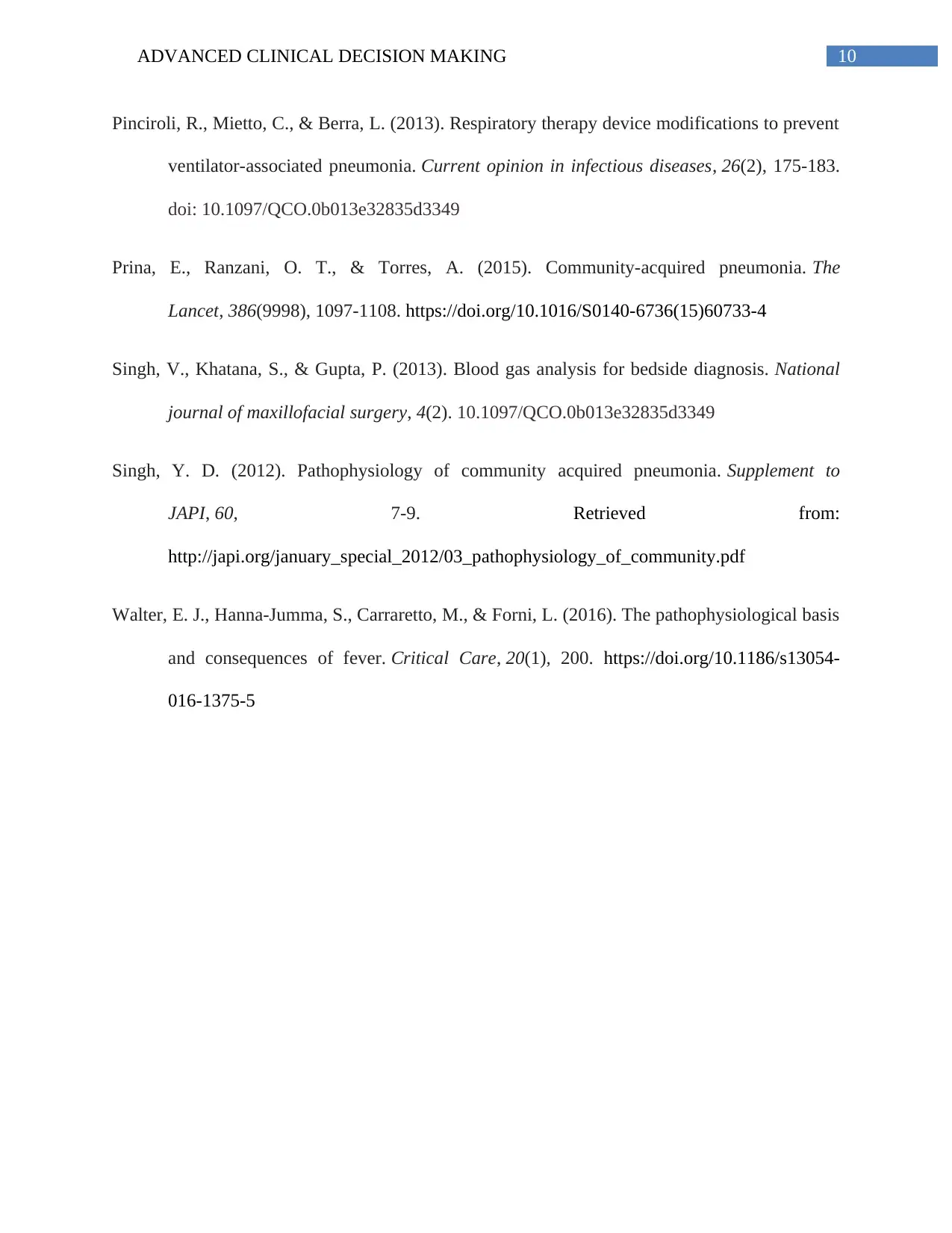
10ADVANCED CLINICAL DECISION MAKING
Pinciroli, R., Mietto, C., & Berra, L. (2013). Respiratory therapy device modifications to prevent
ventilator-associated pneumonia. Current opinion in infectious diseases, 26(2), 175-183.
doi: 10.1097/QCO.0b013e32835d3349
Prina, E., Ranzani, O. T., & Torres, A. (2015). Community-acquired pneumonia. The
Lancet, 386(9998), 1097-1108. https://doi.org/10.1016/S0140-6736(15)60733-4
Singh, V., Khatana, S., & Gupta, P. (2013). Blood gas analysis for bedside diagnosis. National
journal of maxillofacial surgery, 4(2). 10.1097/QCO.0b013e32835d3349
Singh, Y. D. (2012). Pathophysiology of community acquired pneumonia. Supplement to
JAPI, 60, 7-9. Retrieved from:
http://japi.org/january_special_2012/03_pathophysiology_of_community.pdf
Walter, E. J., Hanna-Jumma, S., Carraretto, M., & Forni, L. (2016). The pathophysiological basis
and consequences of fever. Critical Care, 20(1), 200. https://doi.org/10.1186/s13054-
016-1375-5
Pinciroli, R., Mietto, C., & Berra, L. (2013). Respiratory therapy device modifications to prevent
ventilator-associated pneumonia. Current opinion in infectious diseases, 26(2), 175-183.
doi: 10.1097/QCO.0b013e32835d3349
Prina, E., Ranzani, O. T., & Torres, A. (2015). Community-acquired pneumonia. The
Lancet, 386(9998), 1097-1108. https://doi.org/10.1016/S0140-6736(15)60733-4
Singh, V., Khatana, S., & Gupta, P. (2013). Blood gas analysis for bedside diagnosis. National
journal of maxillofacial surgery, 4(2). 10.1097/QCO.0b013e32835d3349
Singh, Y. D. (2012). Pathophysiology of community acquired pneumonia. Supplement to
JAPI, 60, 7-9. Retrieved from:
http://japi.org/january_special_2012/03_pathophysiology_of_community.pdf
Walter, E. J., Hanna-Jumma, S., Carraretto, M., & Forni, L. (2016). The pathophysiological basis
and consequences of fever. Critical Care, 20(1), 200. https://doi.org/10.1186/s13054-
016-1375-5
1 out of 11
Related Documents
Your All-in-One AI-Powered Toolkit for Academic Success.
+13062052269
info@desklib.com
Available 24*7 on WhatsApp / Email
![[object Object]](/_next/static/media/star-bottom.7253800d.svg)
Unlock your academic potential
© 2024 | Zucol Services PVT LTD | All rights reserved.




